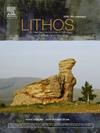上地壳岩浆过程对赛因达克斑岩铜矿床形成的制约:矿物地球化学的启示
IF 2.9
2区 地球科学
Q2 GEOCHEMISTRY & GEOPHYSICS
引用次数: 0
摘要
上地壳岩浆过程在连接斑岩矿床的岩浆和热液系统方面起着至关重要的作用,最终控制着成矿流体的生成。了解岩浆腔内的这些过程对于破解斑岩矿床的形成至关重要。Saindak 矿床是查盖带西部的一个大型斑岩铜矿床系统,其特征是矿石形成和贫瘠岩浆脉冲同时发生,这为斑岩系统的特征描述提供了重要启示。本研究对闪石、斜长石和磷灰石进行了详细的岩相观察和地球化学分析,以揭示赛因达克的岩浆演化过程。根据纹理关系和结晶序列,确定了成矿岩浆中三种不同的闪石群。这些闪石记录了岩浆从最初在 5 千米深处喷出到在 2 千米深处连接岩浆系统的整个分块结晶过程。对闪石和磷灰石的研究表明,肥沃的岩浆在一个开放系统中经历了大规模的流体溶解。岩浆中 Cu、Cl、S 和 H2O 的同时快速消耗表明,Cl 和 S 被高度分配到了外溶流体相中。这些元素形成了络合物,有效地浓缩了流体中的金属。相反,贫瘠岩浆的特点是金属含量低或岩浆腔内流体溶出有限。总之,我们重建了赛因达克的上地壳岩浆过程,并得出结论:通过流体溶出有效提取铜是斑岩矿床形成的关键。本文章由计算机程序翻译,如有差异,请以英文原文为准。
Constraints of upper crust magmatic processes on the formation of Saindak porphyry Cu deposit: Insights from mineral geochemistry
Upper crustal magmatic processes play a crucial role in linking the magmatic and hydrothermal systems of porphyry deposits, ultimately controlling the generation of ore-forming fluids. Understanding these processes within a magma chamber is essential for deciphering the formation of porphyry deposits. The Saindak deposit, a large porphyry Cu system in the western Chagai belt, features coeval ore-forming and barren magma pulses, providing key insights into the characterization of porphyry systems. In this study, detailed petrographic observations and geochemical analyses of amphibole, plagioclase, and apatite were conducted to unravel the magmatic evolution at Saindak. Based on textural relationships and crystallization sequences, three distinct populations of amphibole in the ore-forming magma were identified. These amphiboles record the entire fractional crystallization process of magma that initially emplaced at a depth of ∼5 km to the connected magma system at ∼2 km. The study of amphibole and apatite reveals that the fertile magma underwent large-scale fluid exsolution in an open system. The simultaneous and rapid depletion of Cu, Cl, S, and H2O in the magma indicates that Cl and S were highly partitioned into the exsolved fluid phase. These elements formed complexes, which effectively concentrated metals in the fluid. Conversely, the barren magma was characterized by either low metal content or limited fluid exsolution within the magma chamber. Overall, we reconstruct the upper crustal magmatic processes at Saindak and conclude that efficient extraction of Cu through fluid exsolution is the key to porphyry deposit formation.
求助全文
通过发布文献求助,成功后即可免费获取论文全文。
去求助
来源期刊

Lithos
地学-地球化学与地球物理
CiteScore
6.80
自引率
11.40%
发文量
286
审稿时长
3.5 months
期刊介绍:
Lithos publishes original research papers on the petrology, geochemistry and petrogenesis of igneous and metamorphic rocks. Papers on mineralogy/mineral physics related to petrology and petrogenetic problems are also welcomed.
 求助内容:
求助内容: 应助结果提醒方式:
应助结果提醒方式:


